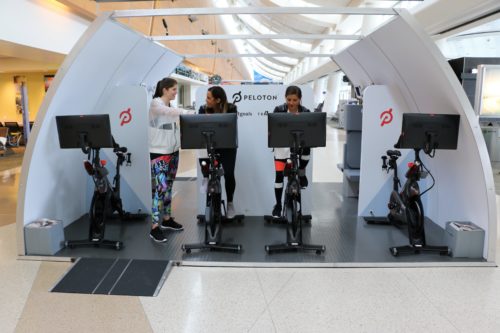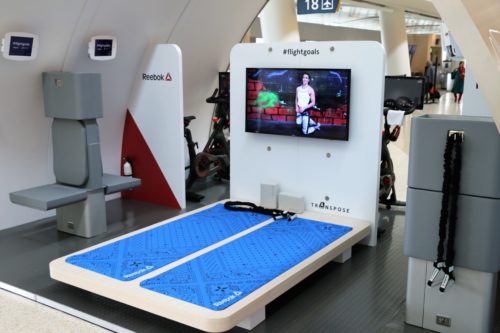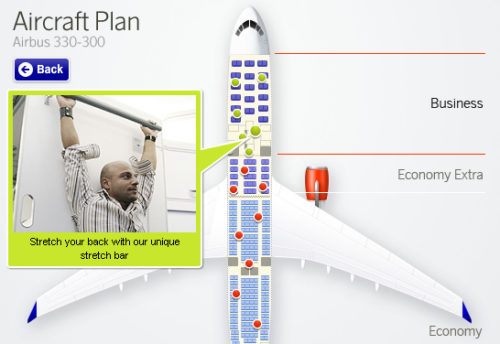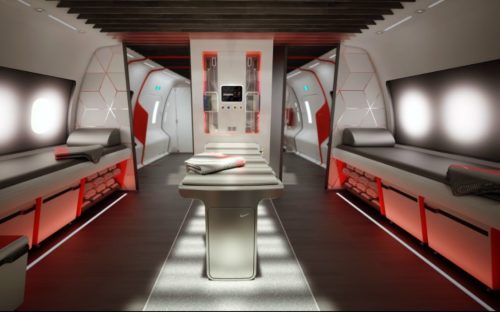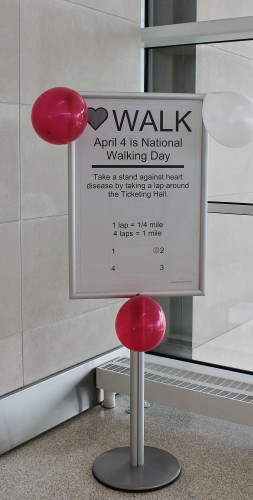Sitting for hours on long-haul flights is bad for both butts and brains, but the standard layout of narrow, forward-facing seats in ever more tightly packed airplane cabins doesn’t offer much option for passenger movement.
But what if you could get out of your seat mid-flight and head to the in-flight gym for a workout – maybe a spinning or yoga class– in a section of the cabin the airline could easily swap out, in plug-and-play fashion, for a kids’ play area or a meeting-friendly café on the next flight?
That’s the idea behind Transpose, a project of Airbus’s Silicon Valley outpost known as A³ which has partnered with Reebok and Peloton to display (through May 19) a prototype ‘flying gym’ module complete with stationary bikes, yoga mats, resistance stations and other workout equipment at Mineta San Jose International Airport.
“For most people, the future of flight will still be on large commercial aircraft,” said Transpose project executive Jason Chua, “We’re trying to allow for new types of in-flight experiences with a modular cabin architecture that allows for customized spaces that can be loaded and unloaded onto aircraft very rapidly.”
Beyond gyms, Transpose cabin modules could be plug-in spas, napping pods, gaming centers, dining areas, yoga studios or, as one traveler suggested, a karaoke lounge. And, Chua suggests, each creative design would offer new ways for both airlines to generate revenue and for brands to engage with flyers beyond putting advertisements on napkins, on tray table stickers, before in-flight movies and in the pages of in-flight magazines.
More ways to carve out the cabin
While quick-change cabin modules may be a new idea, Transpose isn’t the first to suggest using cabin space for activities that promote wellness.
Back in 2002, Scandinavian Airlines (SAS) actively promoted the basic stretching and exercise opportunities offered by a metal bar attached high on a wall in unused space near the galley on some of its long-haul aircraft.
More recently, designers at Seattle-based Teague joined with Nike to envision a Boeing 787 Dreamliner with an interior luxuriously fitted out with amenities for professional and elite college athletes, such as extra-long lie-flat seats, a nutrition zone, biometric monitoring and analyzing systems, a recovery room with massage table, and more.
And last summer, Russian plane maker Sukhoi showed off a concept mock up for a its SportJet, a private jet outfitted for sports teams outfitted with special equipment and lighting, including a variety of in-seat diagnostic devices that will test athletes before, during and after the flight, “to diagnose the physiological and psychological parameters of the athlete’s functionality.”
But while in-flight gyms, yoga studios and other high-flying cabin concepts for commercial airplanes seem intriguing, “A lot of these concepts don’t really account for the business model of air travel,” said Devin Lidell, Principal Brand Strategist at Teague, “They don’t answer the question of how can the airline make money with that, and will someone actually pay for it?”
An entire cabin on a commercial plane outfitted with elliptical machines probably isn’t reasonable – or realistic, said Lidell, “But maybe you could have some seats that are mainly for take-off and landing and then allow passengers to move about the airplane in a different way. Or explore having whole cabins built around passengers with like-minded interests. People may pay more for that.”
When it comes to in-flight wellbeing, for now passengers are limited to walking up and down the aisle (when the drink or meal carts aren’t in the way) or doing stretching exercises – sometimes to the odd glances from other passengers, at their seats.
To help, many airlines offer instructions and encouragement for in-seat exercises on the in-flight entertainment system, in the in-flight magazines or on seat-back cards. Some, like Lufthansa, have recruited sports stars to demonstrate the moves in short videos.
Another, extremely low-tech approach comes from Shanghai-based budget carrier, Spring Airlines, which has instructed its flight attendants to actively encourage passengers to perform in-flight exercises, said Raymond Kollau of AirlineTrends.com.
“Flight attendants announce over the PA that they will be demonstrating in-flight exercises – such as waving hands in the air, massaging temples, or stretching arms – and they recommend everyone do those actions as well,” said Kollau, “And many passengers actually join in.”
(A slightly different version of my story about gyms on airplanes appeared on CNBC)
